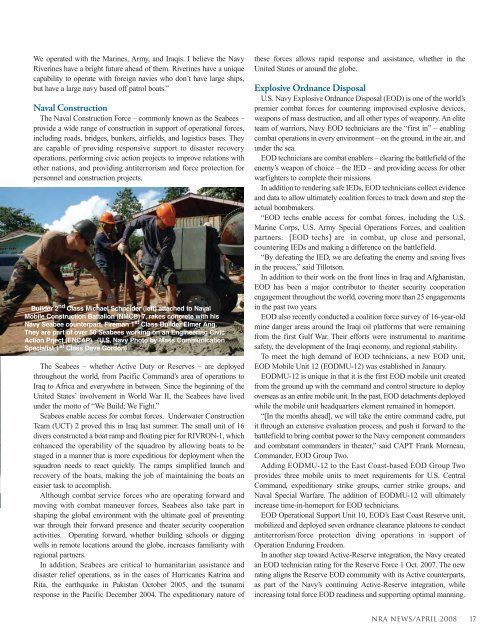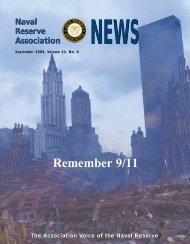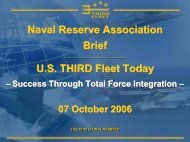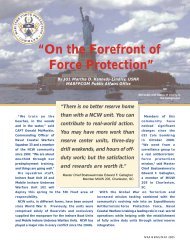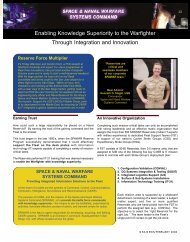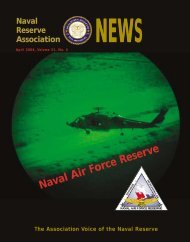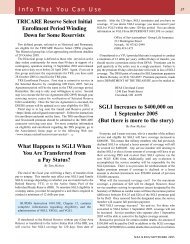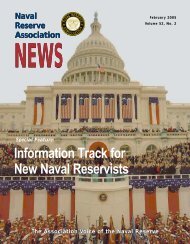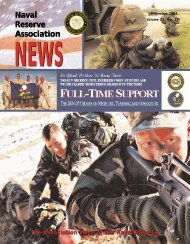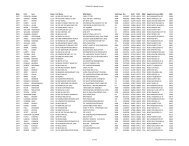Navy Expeditionary Combat Command
Navy Expeditionary Combat Command
Navy Expeditionary Combat Command
You also want an ePaper? Increase the reach of your titles
YUMPU automatically turns print PDFs into web optimized ePapers that Google loves.
We operated with the Marines, Army, and Iraqis. I believe the <strong>Navy</strong>Riverines have a bright future ahead of them. Riverines have a uniquecapability to operate with foreign navies who don’t have large ships,but have a large navy based off patrol boats.”Naval ConstructionThe Naval Construction Force – commonly known as the Seabees –provide a wide range of construction in support of operational forces,including roads, bridges, bunkers, airfields, and logistics bases. Theyare capable of providing responsive support to disaster recoveryoperations, performing civic action projects to improve relations withother nations, and providing antiterrorism and force protection forpersonnel and construction projects.Builder 2 nd Class Michael Schneider (left) attached to NavalMobile Construction Battalion (NMCB) 7, rakes concrete with his<strong>Navy</strong> Seabee counterpart, Fireman 1 st Class Builder Elmer Ang.They are part of over 50 Seabees working on an Engineering CivicAction Prject (ENCAP). (U.S. <strong>Navy</strong> Photo by Mass CommunicationSpecialist 1 st Class Dave Gordon)The Seabees – whether Active Duty or Reserves – are deployedthroughout the world, from Pacific <strong>Command</strong>’s area of operations toIraq to Africa and everywhere in between. Since the beginning of theUnited States’ involvement in World War II, the Seabees have livedunder the motto of “We Build; We Fight.”Seabees enable access for combat forces. Underwater ConstructionTeam (UCT) 2 proved this in Iraq last summer. The small unit of 16divers constructed a boat ramp and floating pier for RIVRON-1, whichenhanced the operability of the squadron by allowing boats to bestaged in a manner that is more expeditious for deployment when thesquadron needs to react quickly. The ramps simplified launch andrecovery of the boats, making the job of maintaining the boats aneasier task to accomplish.Although combat service forces who are operating forward andmoving with combat maneuver forces, Seabees also take part inshaping the global environment with the ultimate goal of preventingwar through their forward presence and theater security cooperationactivities. Operating forward, whether building schools or diggingwells in remote locations around the globe, increases familiarity withregional partners.In addition, Seabees are critical to humanitarian assistance anddisaster relief operations, as in the cases of Hurricanes Katrina andRita, the earthquake in Pakistan October 2005, and the tsunamiresponse in the Pacific December 2004. The expeditionary nature ofthese forces allows rapid response and assistance, whether in theUnited States or around the globe.Explosive Ordnance DisposalU.S. <strong>Navy</strong> Explosive Ordnance Disposal (EOD) is one of the world’spremier combat forces for countering improvised explosive devices,weapons of mass destruction, and all other types of weaponry. An eliteteam of warriors, <strong>Navy</strong> EOD technicians are the “first in” – enablingcombat operations in every environment – on the ground, in the air, andunder the sea.EOD technicians are combat enablers – clearing the battlefield of theenemy’s weapon of choice – the IED – and providing access for otherwarfighters to complete their missions.In addition to rendering safe IEDs, EOD technicians collect evidenceand data to allow ultimately coalition forces to track down and stop theactual bombmakers.“EOD techs enable access for combat forces, including the U.S.Marine Corps, U.S. Army Special Operations Forces, and coalitionpartners. [EOD techs] are in combat, up close and personal,countering IEDs and making a difference on the battlefield.“By defeating the IED, we are defeating the enemy and saving livesin the process,” said Tillotson.In addition to their work on the front lines in Iraq and Afghanistan,EOD has been a major contributor to theater security cooperationengagement throughout the world, covering more than 25 engagementsin the past two years.EOD also recently conducted a coalition force survey of 16-year-oldmine danger areas around the Iraqi oil platforms that were remainingfrom the first Gulf War. Their efforts were instrumental to maritimesafety, the development of the Iraqi economy, and regional stability.To meet the high demand of EOD technicians, a new EOD unit,EOD Mobile Unit 12 (EODMU-12) was established in Janaury.EODMU-12 is unique in that it is the first EOD mobile unit createdfrom the ground up with the command and control structure to deployoverseas as an entire mobile unit. In the past, EOD detachments deployedwhile the mobile unit headquarters element remained in homeport.“[In the months ahead], we will take the entire command cadre, putit through an extensive evaluation process, and push it forward to thebattlefield to bring combat power to the <strong>Navy</strong> component commandersand combatant commanders in theater,” said CAPT Frank Morneau,<strong>Command</strong>er, EOD Group Two.Adding EODMU-12 to the East Coast-based EOD Group Twoprovides three mobile units to meet requirements for U.S. Central<strong>Command</strong>, expeditionary strike groups, carrier strike groups, andNaval Special Warfare. The addition of EODMU-12 will ultimatelyincrease time-in-homeport for EOD technicians.EOD Operational Support Unit 10, EOD’s East Coast Reserve unit,mobilized and deployed seven ordnance clearance platoons to conductantiterrorism/force protection diving operations in support ofOperation Enduring Freedom.In another step toward Active-Reserve integration, the <strong>Navy</strong> createdan EOD technician rating for the Reserve Force 1 Oct. 2007. The newrating aligns the Reserve EOD community with its Active counterparts,as part of the <strong>Navy</strong>’s continuing Active-Reserve integration, whileincreasing total force EOD readiness and supporting optimal manning.NRA NEWS/APRIL 2008 17


